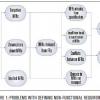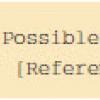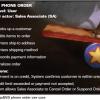Requirements
Better Software Magazine Articles
 |
Pairwise Testing: An Easy Guide to Orthogonal Arrays & All-Pairs Combinations One of the testing challenges we face is how to handle the large numbers of test cases we sometimes need to create and execute. We can't test everything, but pairwise testing using orthogonal arrays or an all-pairs algorithm can help generate pair combinations that reduce the number of test cases we run while still finding a large percentage of bugs. |
Lloyd Roden
September 26, 2007 |
 |
Navigating the Installation If you've ever popped a CD into a drive and run an install for software you're about to test, then you might be performing installation testing indirectly. If not properly installed, an application could give false results for all other testing. A better strategy is to test the install process directly, which will give you greater confidence in the quality of your software. |
|
|
The Whorfian Hypothesis Benjamin Whorf hypothesized that the language we speak constrains the thoughts we can have. Learn how a well-developed organizational vocabulary can help increase the quality of your products. |
||
 |
Know What's at Stake Everyone knows the importance of well-defined functional requirements. We want our products to work, don't we? But how many of us are paying as much attention to defining our non-functional requirements? In this historically focused feature, we learn from past mistakes the potentially disastrous results of inadequately tested NFRs. |
|
|
Rock, Paper, Scissors: How Testers Uncover Hidden Requirements The requirements process is not a linear one. In this article, Michael Bolton helps you get in the game by showing how the elements of the requirements process–reference, inference, and conference–interact and influence each other. |
||
|
Test to Impress: Getting the Most Out of Ajax Developer Tools Ajax applications are very popular and can be flexible and dynamic, but only if you find the bugs first. Stuart Halloway has the details on tools that Ajax developers use and that will keep your applications dressed to the nines. |
Stuart Halloway
September 5, 2006 |
|
 |
From Primitive to Prominent: The Past, Present, and Future of Automated Code Analysis Automated code analysis tools are becoming more powerful and more necessary than ever before. Alberto Savoia takes a look at the evolution of static and dynamic code analysis tools, from their humble beginnings to their present status as indispensable technology, and tells us what he predicts for the future. |
Alberto Savoia
June 26, 2006 |
|
|
A Look at Administrator's Pak by Winternals Find out more about this suite of utilities that allows testers to repair locked-out systems, restore lost data, remove malware, and much more. |
Marnie Hutcheson
March 6, 2006 |
|
The Case of the Missing IF Grandma cooked her roast a certain way, and now you're repeating the process without knowing why you have to trim the ends off an uncooked roast even though the pan is adequately sized. Relic processes in many organzations fall trap to this mindset since the reason behind the action lost its meaning long ago. Lee Copeland calls these "IF ..., THEN ..." processes. When the organization loses sight of the IF responsible for the action, then you're left with what Lee describes as "a process without a context; a rule without a reason." |
||
 |
What Goes Up Must Come Down Writing requirements purely top-down or only bottom-up is risky to say the least. The devil's in the details, and those details are likely to be missed when working from a single direction. What if you could tackle your requirements from both directions by incorporating use cases and user centered design? Learn how balancing your approach to writing requirements can result in more detailed, pragmatic documentation. |






